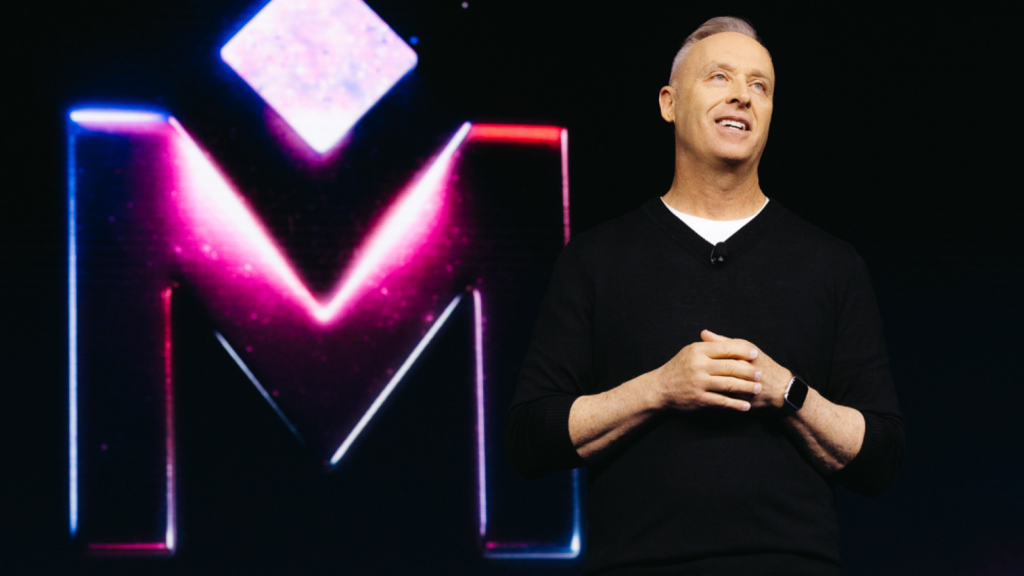Discover the four customer experience organizational structures that exist today, as well as the pros and cons of each.
The way your customer experience (CX) team is organized can be the difference between success and failure. I should know, I’ve tried so many different iterations over my 20-year career as a CX practitioner and leader. Each has its own set of advantages and disadvantages.
We’ll explore each CX team archetype below, including their pros and cons, so you can determine which model is right for your organization to best operationalize customer experience.
The Centralized Model
What It Is
This model is characterized by the decision-making regarding program evolution and improvement initiatives being centralized to a specific individual or team. As part of this archetype, activities such as budget, change management, best practice implementation, and overall governance are also centralized.
A central team facilitates both inner- and outer-loop discussions for actions to be taken. While somewhat dated, there are benefits to a centralized archetype. Specifically, there are easier decision-making processes and faster execution when there is a strong connection to the business, and clear lines of accountability.
The line of business, or LOB, could be a bank’s credit card or mortgage business; alternatively, an LOB can be characterized by a client segment.
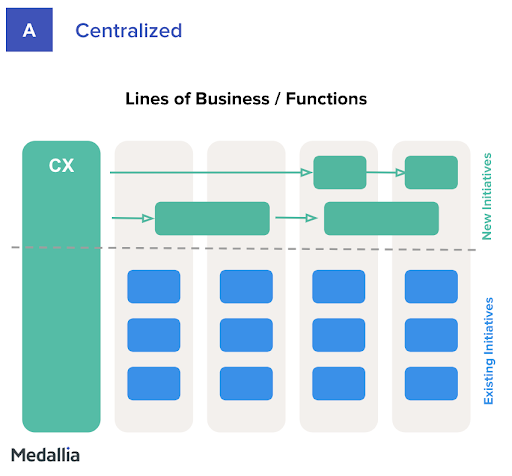
Does It Work?
There are a number of “cons” to this model, and, frankly, they outweigh the benefits. First, this approach can lead to inflexible behavior and autocratic leadership, as there is no shared responsibility across the business. In addition, centralized teams can hinder creativity and can impact local teams’ abilities to drive action more quickly if the CX team becomes a bottleneck.
Finally, centralized teams, in my experience, can end up “owning” the customer experience versus partnering closely with business stakeholders to empower them to take action. This creates lack of accountability for the experience, which can result in customer churn or reduced revenue.
The Decentralized Model
What It Is
Decentralized archetypes are characterized by each LOB having its own CX team and each supporting both new and existing initiatives for that specific LOB. There are also customer experience program owners in each line of business, where decision-making and program execution sits within each silo.
As different business lines can have different goals, program management and responsibilities are aligned accordingly.
Budgets for customer experience initiatives can be shared across functions; however, as each business manages its own Profit & Loss, this is not common. Each business manages its own budget for CX resources, technology, and initiatives.
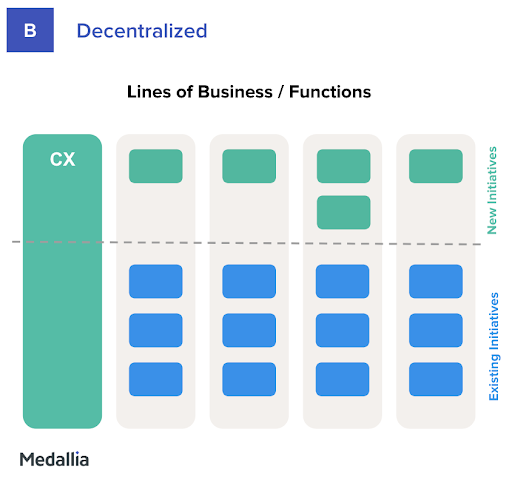
Does It Work?
In a decentralized model, there is greater flexibility to address business-specific needs. Moreover, closed-loop feedback processes can be localized for greater impact. But decentralized CX functions are characterized by a lack of a shared CX vision and strategy, as one exists for each LOB. Moreover, many organizations that have applied this model lack clear executive sponsorship. Finally, as each business drives its own CX initiatives without a shared strategy, duplicative actions, investments, and processes lead to significant inefficiencies.
In this model, customers can sometimes feel like they are dealing with different versions of the same company if they purchase products and services across the lines of business. This scenario can often be found in product-led industries such as banking and insurance.
The Federated Model
What It Is
Federated, or hybrid, models are what most organizations have put in place today to manage and lead CX for their company. This model is characterized by a central advisory or governance with accountability driven into each LOB. A core CX team focuses on methodologies, systems and technology, and best practices, while execution is within the business units. This model brings together the centralized and decentralized archetypes, however, the key distinction is the existence of a centralized council that consists of cross-functional leaders from each LOB.
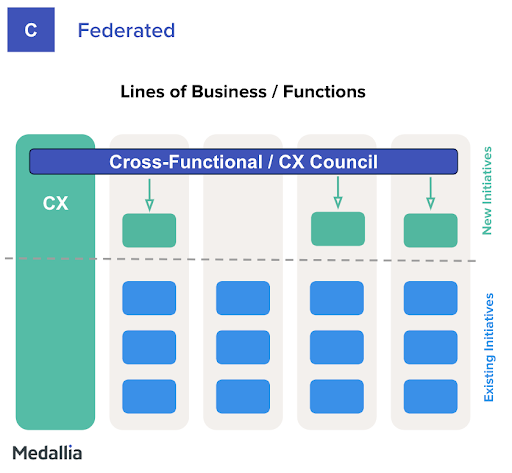
Does It Work?
While this can create some complexity in decision-making and speed of execution given the multiple constituencies involved, the benefits far outweigh the disadvantages.
To note, this model drives streamlined and standardized governance and processes across the organization, and creates mutual lines of accountability. Because there is a leader representing each line of business, there is flexibility to quickly address localized needs, but with the added benefit of leveraging a council of peers for best practices. There is also a shared CX vision and strategy that all stakeholders agree on and follow. This vision and strategy is created, owned, and managed by the core CX team and a dedicated CX leader who works across the business lines to ensure consistency.
The beauty of a federated model is that it does not require more resources than a centralized approach. Both come down to how effective the CX leader is at engaging and influencing across the company, and how effectively the CX team can show the business value they drive each day.
The Journey-Led Model
What It Is
A fourth, and increasingly popular, approach to leading customer experience is the journey-led archetype. This model has been adopted by organizations that show more advanced thinking in CX delivery.
Here, the LOBs and the CX function are organized into journeys teams. Some organizations look at product owners leading multiple product teams as journey owners.
For the customer experience function specifically, the journey teams sit within a core team, similar to the federated model. These journey team members provide direct support to the journey partners that sit within each LOB.
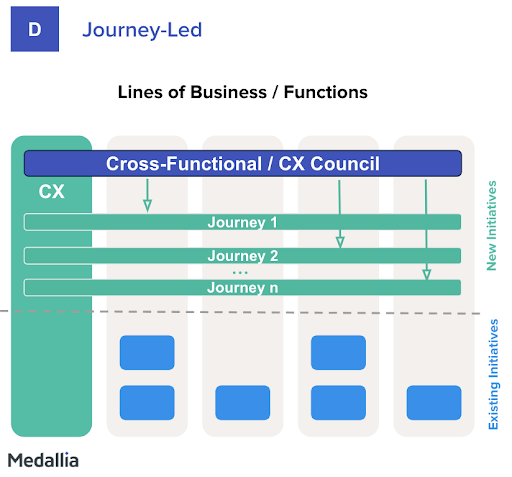
Does It Work?
One of the greatest outcomes of this model is a new set of KPIs and metrics that measure customer experience success across the organization versus within an individual line of business. For example, customer lifetime value (CLV) becomes increasingly important in this model, as CLV is a metric that allows you to look horizontally across a business.
Other metrics that measure business outcomes across the journey are also fundamental to measuring success. While companies that have employed this model still measure customer satisfaction within specific transactions, the Net Promoter Score can take on new meaning, as it truly is a relationship-level measurement.
CX Organizational Structures: What’s Best For Your Company?
Each of these archetypes are in practice today. Each has its own merits and drawbacks. Customer experience teams need to consider what archetype would have the greatest impact for the business they are in, and if it can best serve the needs of customers and the workforce. While some archetypes are now favored more than others, at the end of the day, it comes down to leadership commitment, vision & strategy, and execution.
Check out our Expert Insight guide, How to Launch a Customer Experience Program, to discover what goes into designing, introducing, and improving a successful CX program.









